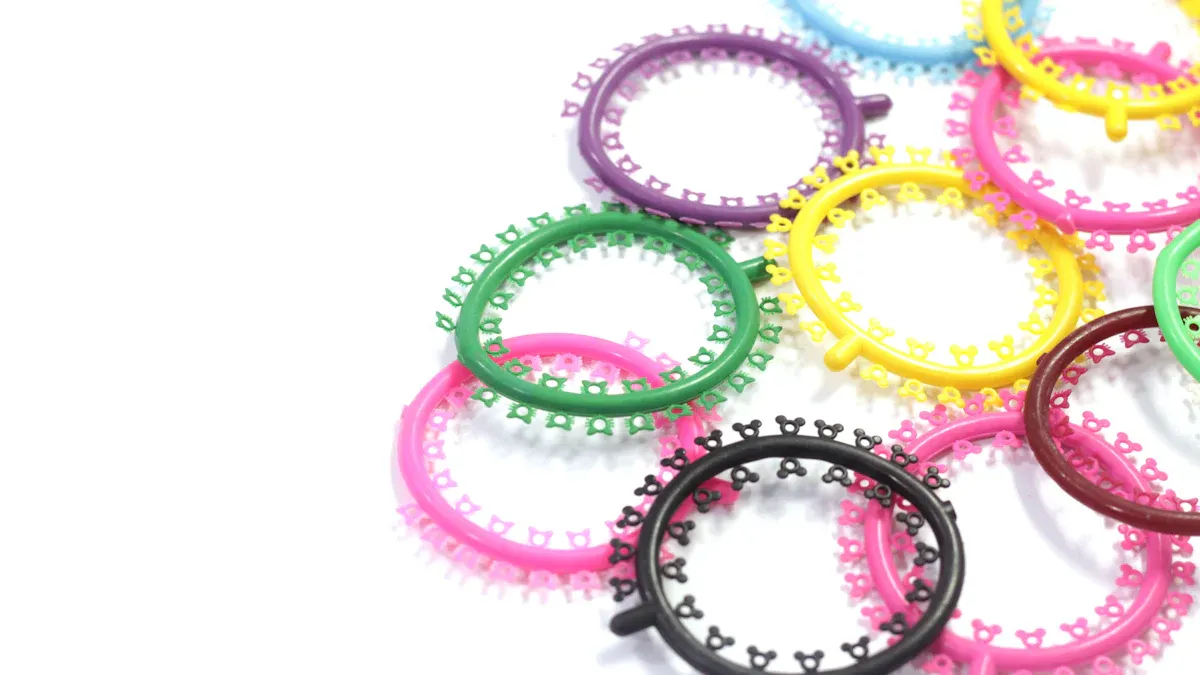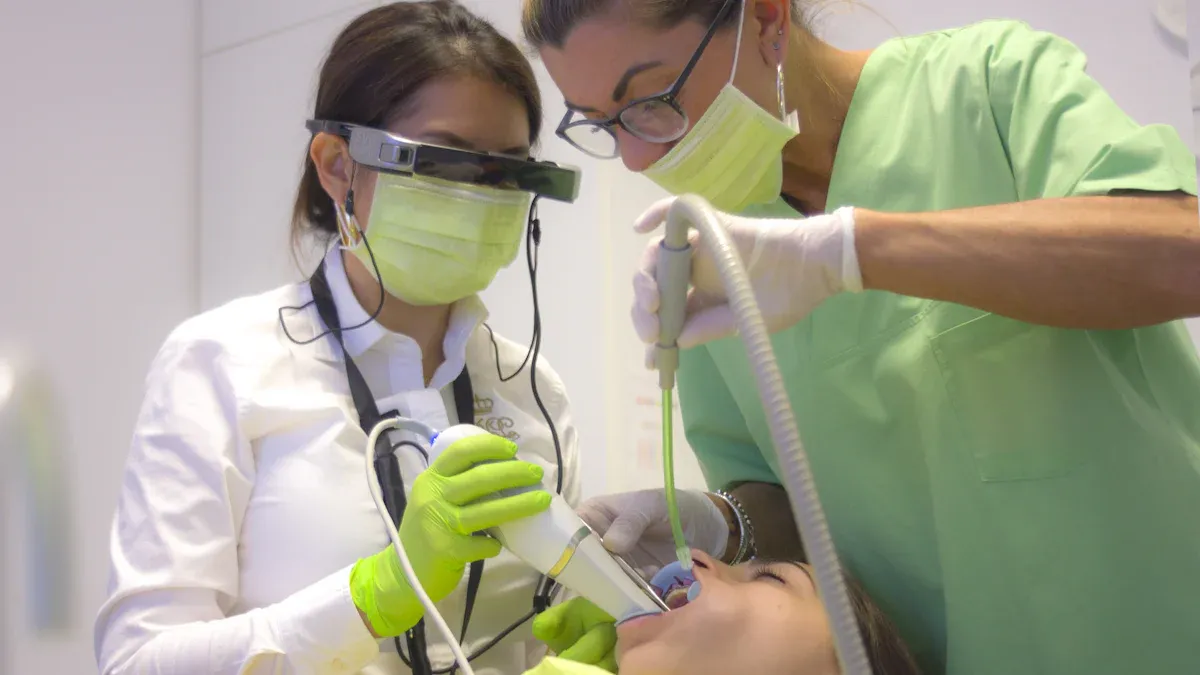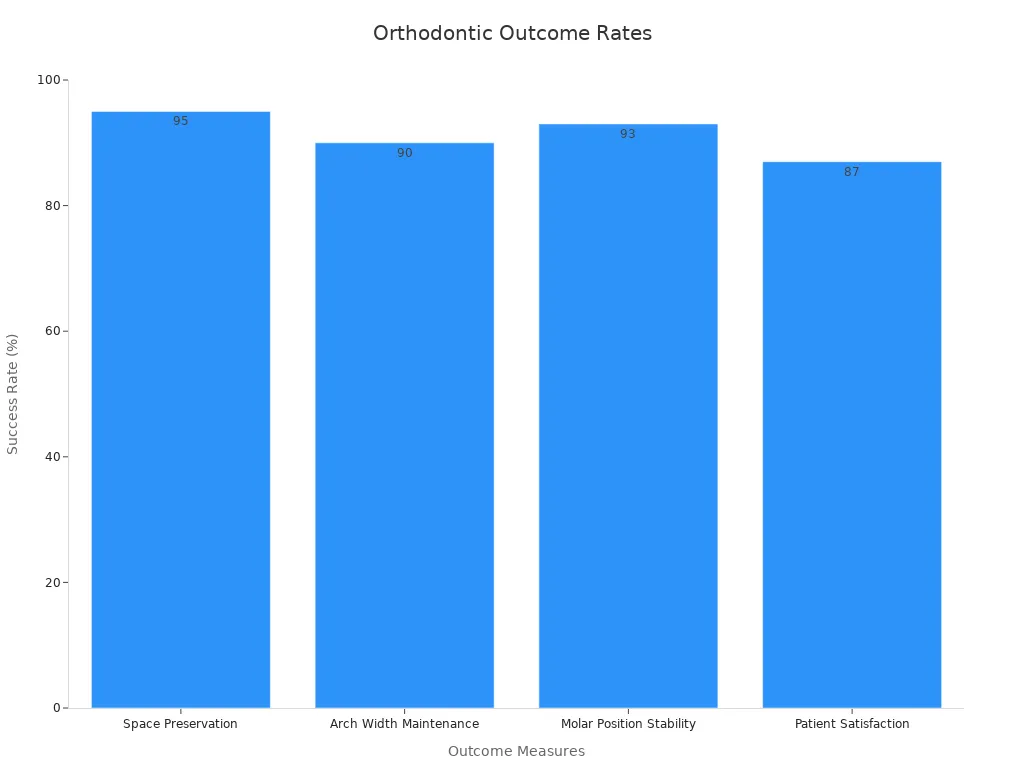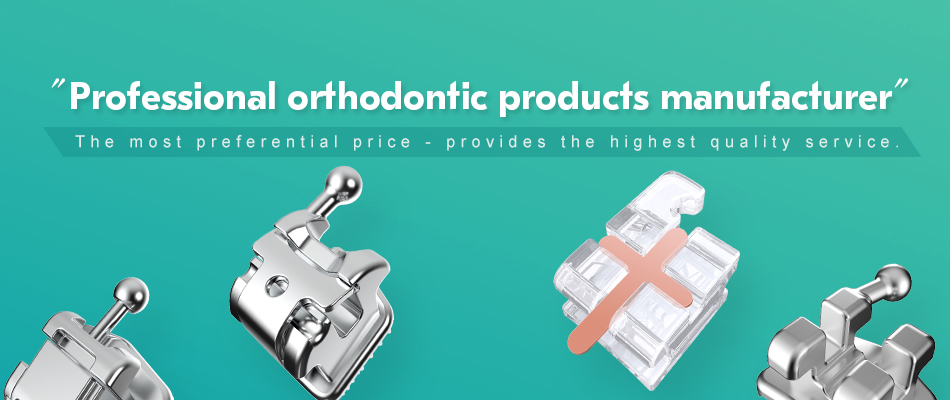CE certification serves as a trusted standard for ensuring the safety and quality of medical products, including those used in pediatric dentistry. It guarantees that orthodontic products meet stringent European health, safety, and environmental protection requirements. This certification is especially vital for children, as their developing teeth and gums require extra care.
Using certified, child-safe products in pediatric dentistry not only protects young patients but also builds trust between parents and dental professionals. Studies show that 89% of dentists and hygienists feel more confident providing care for young children after engaging with CE-certified programs. This confidence translates into better outcomes for children and peace of mind for families.
Prioritizing safety and certification in orthodontic products for pediatric dentistry ensures healthier smiles and a brighter future for every child.
Key Takeaways
- CE certification means orthodontic products are safe and high-quality for kids.
- Certified products help parents trust dentists, improving kids’ treatment results.
- Visit a certified kids’ dentist to pick the best products for your child.
- Regular check-ups are important to track treatments and check product success.
- Choose comfortable and easy-to-use products to make visits less stressful.
CE Certification and Its Importance in Pediatric Dentistry
What is CE certification?
CE certification is a mark of quality and safety recognized across Europe. It ensures that products meet strict health, safety, and environmental standards. For orthodontic products, this certification guarantees that they are safe for use, especially for children. Manufacturers must comply with rigorous guidelines, including ISO 13485, which focuses on quality management in medical device production. This standard emphasizes risk management throughout the product lifecycle, ensuring that every product is safe and effective for young patients.
How CE certification ensures safety and quality
CE certification acts as a safeguard for both patients and dental professionals. It requires manufacturers to follow strict protocols during production. For example, orthodontic products must undergo extensive testing to ensure they are free from harmful materials and meet durability standards. The certification also aligns with FDA approval for products sold in the U.S., further ensuring their safety and effectiveness. These measures are particularly important for pediatric dentistry, where the safety of growing teeth and gums is a top priority.
Why CE certification matters for orthodontic products for children
CE certification plays a vital role in pediatric orthodontics. It signifies that products meet the highest safety and quality standards, which is crucial for children’s dental health. Certified products not only protect young patients but also enhance the credibility of suppliers and dental professionals. Parents feel reassured knowing that their child’s orthodontic care involves products that adhere to stringent safety regulations. This trust fosters better relationships between families and dental providers, leading to improved outcomes for children.
CE certification is more than a label—it’s a promise of safety, quality, and care for every child’s smile.
Key Features of Orthodontic Products for Pediatric Dentistry

Use of non-toxic, biocompatible materials
Orthodontic products designed for children must prioritize safety above all else. Non-toxic, biocompatible materials ensure that these products do not pose any health risks to young patients. This is particularly important because children’s developing bodies are more sensitive to harmful substances. For instance:
- Research highlights the risks of Bisphenol A (BPA) leaching from orthodontic devices, which can have estrogenic and cytotoxic effects.
- The need for safer alternatives becomes evident due to inconsistencies in the safety of some clear aligners.
By using biocompatible materials, manufacturers create products that are safe for prolonged use, reducing the risk of adverse reactions. This commitment to safety fosters trust among parents and dental professionals, ensuring children receive the best care possible.
Ergonomic designs tailored for children
Orthodontic products for pediatric dentistry must go beyond functionality. They should also address the emotional and psychological needs of children. Ergonomic designs play a crucial role in achieving this balance. Products tailored for children often feature smaller, more comfortable shapes that fit their mouths perfectly.
Studies show that ergonomic designs in healthcare settings can reduce anxiety and improve patient satisfaction. For children, user-centered designs create a sense of familiarity and comfort, making dental visits less intimidating.
Additionally, orthodontic products with child-friendly designs can enhance compliance. When children feel at ease with their devices, they are more likely to follow treatment plans, leading to better outcomes.
Durability and reliability for growing mouths
Children’s teeth and jaws are constantly changing as they grow. Orthodontic products must adapt to these changes while maintaining their effectiveness. Durable materials ensure that brackets, wires, and other devices withstand the wear and tear of daily use. Reliable products also minimize the need for frequent replacements, saving time and reducing costs for families.
Manufacturers achieve this durability by using advanced production techniques and high-quality materials. For example, Denrotary Medical employs cutting-edge German equipment to produce orthodontic products that meet the highest standards. This focus on durability ensures that children receive consistent, effective care throughout their treatment journey.
Examples of CE-Certified Orthodontic Products for Children

Brackets and wires for pediatric orthodontics
Brackets and wires remain essential tools in pediatric orthodontics. These components guide teeth into proper alignment, ensuring a healthy bite and a confident smile. CE-certified brackets and wires are crafted from high-quality, biocompatible materials that prioritize safety and comfort. Their smooth edges and precise designs minimize irritation, making them ideal for children.
Modern advancements have introduced smaller, more discreet brackets that reduce discomfort and improve aesthetics. Paired with flexible wires, these systems adapt to the unique needs of growing mouths. This combination ensures effective treatment while maintaining a child-friendly experience.
Clear aligners designed for children
Clear aligners offer a modern alternative to traditional braces. These transparent, removable trays are custom-made to fit a child’s teeth, gradually shifting them into the desired position. CE-certified aligners for children are made from non-toxic, BPA-free materials, ensuring safety during prolonged use.
Their removable nature allows children to maintain proper oral hygiene, reducing the risk of cavities and gum issues. Additionally, clear aligners are nearly invisible, boosting a child’s confidence throughout their orthodontic journey. With regular monitoring by a pediatric dentist, these aligners provide a safe and effective solution for mild to moderate alignment issues.
Retainers and space maintainers
Retainers and space maintainers play a crucial role in preserving the results of orthodontic treatments. Retainers help maintain teeth alignment after braces or aligners, while space maintainers prevent adjacent teeth from shifting into gaps left by missing teeth. CE-certified options ensure these devices meet the highest safety and durability standards.
The performance of retainers and space maintainers in pediatric orthodontics is remarkable. The following table highlights measurable outcomes:
| Outcome Measure | Success Rate |
|---|---|
| Space Preservation | 95% |
| Arch Width Maintenance | 90% |
| Molar Position Stability | 93% |
| Patient Satisfaction | 87% |
These devices also deliver expected results, such as maintaining leeway space (2-4 mm) and preventing molar drift. Treatment durations typically range from 12 to 24 months.

By choosing CE-certified retainers and space maintainers, parents and dentists can ensure long-term success and satisfaction for children undergoing orthodontic care.
Additional accessories like mouthguards and expanders
Orthodontic care for children often extends beyond braces and aligners. Accessories like mouthguards and expanders play a vital role in protecting and shaping young smiles. These tools, when CE-certified, ensure safety and effectiveness, giving parents and dentists peace of mind.
Mouthguards: Protection for Active Lifestyles
Children who participate in sports or other physical activities face a higher risk of dental injuries. Mouthguards act as a shield, protecting teeth, gums, and jaws from impact. CE-certified mouthguards are crafted from non-toxic, durable materials that provide a snug fit and maximum comfort.
Tip: Encourage children to wear mouthguards during sports to prevent chipped teeth or jaw injuries. A well-fitted mouthguard can reduce the risk of dental trauma by up to 60%.
Customizable options, such as those offered by Denrotary Medical, allow for a perfect fit tailored to each child’s unique dental structure. These mouthguards not only safeguard oral health but also boost confidence, enabling children to focus on their activities without worry.
Expanders: Creating Space for Growing Smiles
Palatal expanders are essential for addressing issues like overcrowding or crossbites. These devices gently widen the upper jaw, creating space for permanent teeth to grow in alignment. CE-certified expanders ensure biocompatibility and durability, making them safe for prolonged use.
Expanders work gradually, applying consistent pressure to guide jaw development. This process not only improves dental alignment but also enhances facial symmetry. Parents often notice significant improvements in their child’s smile within months of using an expander.
Note: Regular check-ups with a pediatric dentist ensure that expanders function effectively and adjustments are made as needed.
By incorporating accessories like mouthguards and expanders into orthodontic care, children can enjoy healthier, more confident smiles. These tools, backed by CE certification, represent a commitment to safety, quality, and long-term dental success.
How to Choose the Right Orthodontic Products for Pediatric Dentistry
Consulting with a certified pediatric dentist
Choosing the right orthodontic products begins with consulting a certified pediatric dentist. These professionals possess the expertise to evaluate a child’s dental health and recommend suitable solutions. They consider factors like the child’s age, oral development, and specific orthodontic needs. A certified dentist ensures that the selected products align with safety standards and treatment goals.
Parents should feel empowered to ask questions during consultations. Inquiring about the materials, design, and durability of recommended products fosters trust and transparency. Pediatric dentists often collaborate with trusted manufacturers, such as Denrotary Medical, to provide high-quality options tailored to children. This partnership guarantees that young patients receive safe and effective care.
Checking CE certification and product labels
Verifying CE certification and product labels is a critical step in selecting orthodontic products for children. CE marking signifies compliance with stringent European safety, health, and environmental standards. It ensures that the products are free from harmful substances and meet durability requirements.
Parents and dentists should carefully inspect product labels for the CE mark. This simple step safeguards against non-compliant devices that could compromise a child’s safety. Non-certified products may lead to legal issues or adverse health effects. By prioritizing CE-certified options, families can confidently choose orthodontic products that protect their child’s growing smile.
- CE certification guarantees:
- Compliance with EU safety and health standards.
- Assurance of product quality and reliability.
- Protection against potential risks associated with non-compliant devices.
Assessing the child’s specific dental needs
Every child’s dental journey is unique. Assessing their specific needs ensures that the chosen orthodontic products deliver optimal results. Factors like the severity of misalignment, oral hygiene habits, and lifestyle preferences play a significant role in product selection. For example, active children may benefit from durable mouthguards, while those with mild alignment issues might prefer clear aligners.
A systematic approach can simplify the decision-making process. The table below outlines key guidelines for selecting the right products:
| Guideline | Description |
|---|---|
| Ensuring patient safety and comfort | Prioritize high-quality orthodontic supplies to minimize risks and enhance patient comfort. |
| Evaluating long-term cost-effectiveness | Analyze initial investments versus long-term savings to optimize inventory costs. |
| Learning from peer recommendations | Consult colleagues and online reviews to identify reliable and cost-effective products. |
| Trial runs for new tools | Test new tools on a small scale to assess their functionality and impact before large purchases. |
By following these guidelines, parents and dentists can make informed decisions that prioritize safety, comfort, and effectiveness. This thoughtful approach ensures that children receive the best possible care throughout their orthodontic journey.
Prioritizing comfort and ease of use
Orthodontic products designed for children must prioritize comfort and ease of use to ensure successful treatment outcomes. When children feel at ease with their orthodontic devices, they are more likely to follow treatment plans and maintain positive attitudes toward dental care. This focus on comfort not only improves compliance but also fosters a sense of trust between young patients, parents, and dental professionals.
Comfortable orthodontic products often feature smooth edges, lightweight materials, and ergonomic designs. These features reduce irritation and enhance the overall experience for children. For example, brackets with rounded corners or clear aligners with a snug fit minimize discomfort during wear. Similarly, user-friendly retainers and expanders simplify daily routines, making it easier for children to adapt to their orthodontic journey.
Ease of use also plays a critical role in the effectiveness of orthodontic tools. High-quality products streamline treatment processes and improve patient satisfaction. Dental staff often provide valuable feedback on the usability and efficiency of these tools, helping manufacturers refine their designs. This collaboration ensures that orthodontic products meet the needs of both professionals and patients.
- Benefits of prioritizing comfort and ease of use include:
- Enhanced patient compliance with treatment plans.
- Reduced anxiety during dental visits.
- Improved satisfaction for both children and parents.
By choosing orthodontic products that prioritize comfort and ease of use, dental professionals can create a positive experience for young patients. This approach not only supports better treatment outcomes but also encourages children to develop lifelong habits of caring for their smiles. A comfortable and user-friendly orthodontic journey paves the way for healthier, happier smiles that last a lifetime.
The Role of Parents and Dentists in Ensuring Safety
Educating parents about orthodontic product safety
Parents play a vital role in ensuring their child’s orthodontic journey is safe and effective. Educating them about the importance of using certified products empowers them to make informed decisions. Parents with higher oral health literacy (OHL) are more likely to schedule regular dental visits for their children. This proactive approach ensures that potential issues are identified early, reducing risks and improving outcomes.
Dentists can support parents by providing clear, accessible information about orthodontic products. They should explain the significance of CE certification and how it guarantees safety. Visual aids, brochures, or even short videos can simplify complex concepts, making them easier to understand. When parents feel confident in their knowledge, they become active participants in their child’s care, fostering a collaborative environment that benefits everyone.
Regular dental visits and monitoring
Consistent dental check-ups are essential for maintaining the safety and effectiveness of orthodontic treatments. Children who attend regular visits experience better oral health outcomes. Studies show that parents of these children report higher oral health literacy and reduced dental anxiety, which positively impacts their child’s dental care.
Dentists use these visits to monitor the progress of orthodontic treatments and address any concerns. Adjustments to devices, such as braces or expanders, ensure they remain effective as the child grows. A study involving 500 children during remote learning highlighted the importance of continuous monitoring. Those who accessed teledentistry services maintained better oral health compared to those who delayed care. This demonstrates the critical role of regular check-ups in ensuring long-term success.
Encouraging proper use and maintenance of products
Proper use and maintenance of orthodontic products are crucial for achieving desired results. Parents and dentists must work together to teach children how to care for their devices. Simple habits, like cleaning retainers daily or wearing mouthguards during sports, can prevent complications and extend the lifespan of these tools.
Dentists should provide step-by-step instructions and practical demonstrations to ensure children understand how to maintain their devices. Parents can reinforce these lessons at home by supervising their child’s routine. A collaborative effort between parents and dentists creates a supportive environment where children feel motivated to follow their treatment plans. This teamwork ensures safer, healthier smiles for every young patient.
CE certification ensures orthodontic products meet the highest safety and quality standards, protecting children’s growing smiles. This certification builds trust among parents, dentists, and manufacturers, creating a foundation for effective pediatric dental care.
Parents and dentists play a vital role in selecting and maintaining these child-safe products. Their collaboration fosters a supportive environment where children feel confident and cared for throughout their orthodontic journey.
Prioritizing certified products leads to healthier, happier smiles. By choosing safety and quality, families can ensure brighter dental outcomes for every child.
FAQ
What does CE certification mean for orthodontic products?
CE certification ensures that orthodontic products meet strict European safety, health, and environmental standards. It guarantees that these products are safe, effective, and reliable for children. Parents and dentists can trust CE-certified products to provide the highest level of care for young patients.
How can parents verify if a product is CE-certified?
Parents can check for the CE mark on product packaging or labels. This mark indicates compliance with European safety standards. Additionally, consulting with a certified pediatric dentist ensures that only CE-certified products are recommended for their child’s orthodontic care.
Are CE-certified orthodontic products more expensive?
CE-certified products may have a slightly higher cost due to rigorous testing and quality assurance. However, their durability, safety, and effectiveness make them a worthwhile investment. These products reduce the risk of complications, ensuring better long-term outcomes for children’s dental health.
Why are biocompatible materials important in pediatric orthodontics?
Biocompatible materials ensure that orthodontic products do not cause allergic reactions or harm to children’s sensitive gums and teeth. These materials are non-toxic and safe for prolonged use, providing peace of mind for parents and ensuring a comfortable experience for young patients.
How do ergonomic designs benefit children during orthodontic treatment?
Ergonomic designs enhance comfort and reduce anxiety for children. Products tailored to fit smaller mouths minimize irritation and improve compliance with treatment plans. This thoughtful design approach ensures a positive orthodontic experience, encouraging children to embrace their dental care journey with confidence.
Tip: Always consult a pediatric dentist to find the most comfortable and effective orthodontic solutions for your child.
Post time: Mar-29-2025


